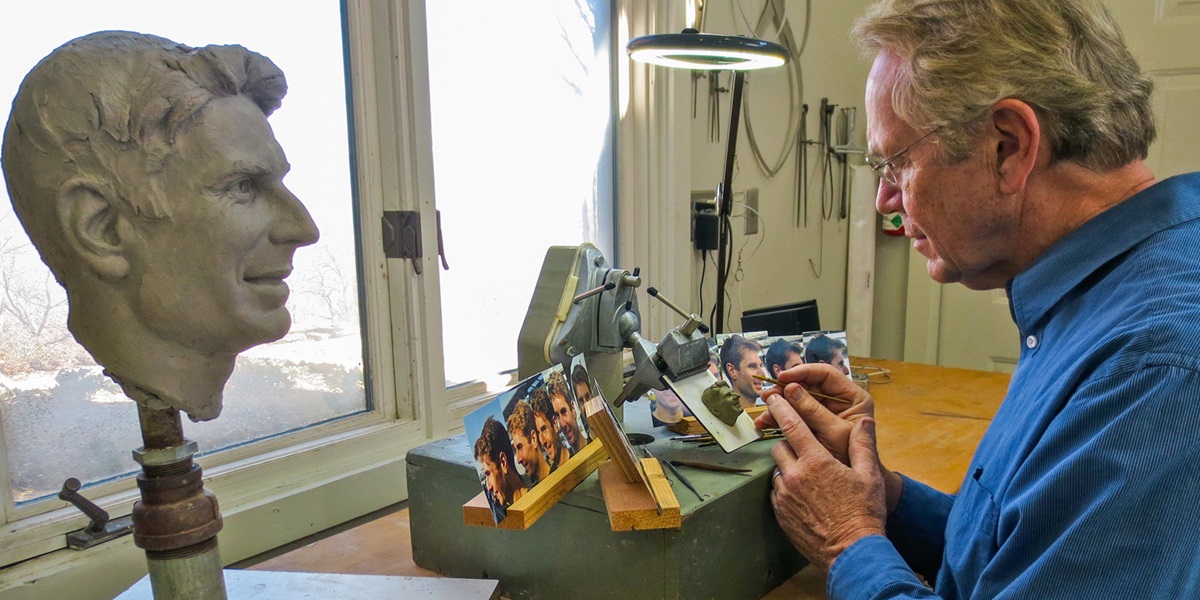
Sculptor Captures Power's 'Joy Of Winning' In Borg-Warner Trophy Likeness
November 28, 2018 | By Jeff Olson
His eyes, intense and piercing, are the first thing people notice about Will Power. As the sculptor tasked with creating a likeness of Power’s face in miniature sterling silver, William Behrends was fascinated by those eyes.
“His eyes are one of the distinct things about him,” Behrends said. “It’s his look, those intense eyes. I certainly did spend time trying to represent those well. It was part of what I was focused on.”
Behrends has finished putting Power’s facial likeness on the Borg-Warner Trophy, which will be unveiled Dec. 5 in a ceremony at the Indianapolis Motor Speedway Museum. It’s Behrends’ 29th face on the famous Indianapolis 500 trophy, and already among his favorites.
“It was rewarding – as rewarding as any other I can recall – because he has a lot of expression and animation in his face,” Behrends said. “I tried to capture what the image represents – the joy of winning in his face. There’s a lot to work with there. Each one is a different challenge. You look for those things in their faces that are really distinctive to them.”
In September, Power visited Behrends’ studio in North Carolina to sit for a full-size bust modeled in clay. From that study, Behrends began working on the smaller version, which was then fitted on the 5-foot 4-inch, 110-pound trophy valued at $3.5 million.
Getting each face just right takes hours of meticulous, miniature sculpting.
“It’s such a small image that it borders on being a caricature,” Behrends said. “You really need to bring out those features that are distinct to that person and emphasize those because it is so small. Will had a lot of that to work with.”
In 1990, Behrends was hired to create a likeness of Arie Luyendyk for the trophy. The following year, he created Rick Mears’ fourth likeness. Since, he’s sculpted six other multiple winners – Luyendyk, Al Unser Jr., Helio Castroneves, Dan Wheldon, Dario Franchitti and Juan Pablo Montoya. He’s also been a part of 10 of Team Penske’s record 17 victories in the Indy 500, including Power’s this year.
The faces are by far his smallest works.
“Everything else I do aside from this is either life-size or over life-size,” Behrends said. “That’s why starting with a life-size bust makes a good study for me. As a sculptor, you’re used to working at a certain scale. You’re more fluid and can do it quicker and better when you’re working at that scale. That’s why the life-size bust helps with that before we go smaller with it.”
Behrends’ other famous sports-related works come in larger scales. He’s the artist behind appropriately giant statues of Giants baseball greats Willie Mays, Willie McCovey, Orlando Cepeda, Juan Marichal and Gaylord Perry that stand outside AT&T Park in San Francisco. Earlier this year, Behrends’ sculpture of San Diego Padres Hall of Fame relief pitcher Trevor Hoffman was unveiled outside Petco Park in San Diego.
Working on likenesses as small as the Borg-Warner faces – about 1 inch by 3 inches each – is demanding but enjoyable, Behrends said.
“It’s something I’ve learned and gotten better at that challenge during these 29 years,” he said. “It is challenging. It’s so darned small that it’s a challenge to get all the details right and represent all the expression and likeness and all the things you look for in a portrait sculpture.”
Through the years, Behrends has continued to perfect his process for creating the tiny silver faces, using a step-by-step procedure to bring life to the trophy.
“I’ve refined my process,” he said. “I’ve added different steps to the process that help me work in that scale. Twenty-nine years ago, this was the first time I’d done something in that small a scale. It took a little figuring out technically how I was going to get it done.”
Now, 28 faces later, Behrends is honored to be a part of it all.
“I’m a race fan, and I’ve been very familiar with the Indy 500 and the Borg-Warner Trophy my entire life,” he said. “It’s an honor to have my work on there, especially now that it’s almost three decades. I feel very honored to have had the opportunity to do that for so long now.”